Science - Nature - Cosmology - Muses and More
Mission Mars
Mission Mars Background
Anyone who follows developments in space exploration will be well aware that Mars is one of the most talked about planets to which manned missions are on the horizon. At 78 million km from Earth, Mars is our second closest planet when in conjunction. Venus is the nearest but unlike Venus, which is extremely inhospitable, the conditions on Mars make it possible for a surface landing and potentially for humans to live there in controlled environments.
Mars is a lot smaller than Earth – Earth has a diameter of 12,756km whereas Mars is almost half the size at 6792km. Interestingly the day length and year on Mars is almost the same as ours. There are 24.7 hours in a Martian day and 687 Earth days in the year.
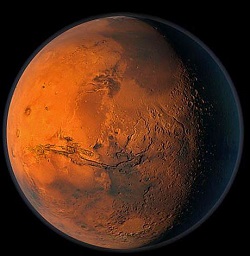
Mars, known as ‘the red planet’, mainly consist of dusty plains, has polar icecaps, canyons, valleys, dried up water courses and old volcanoes. This parched cold barren rock however does show its history under the dust. There are glimpses of what could be signs of conditions where life could have existed.
Billions of years ago Mars is thought to have been similar in some ways to Earth. It had a thick atmosphere which supported oceans of water. It is now a frozen arid desert – all the seas have gone. No one knows for sure what happened to change Mars from an Earth like planet to its current state but the missions that have visited Mars and future missions are endeavouring to answer this question and more.
In 1964, Mariner 4 made the first flyby of Mars taking close up images. The Mariner 9 mission managed to get into orbit and photograph about 80% of the Martian surface. In 1975, the Viking Programme landed on Mars for the first time. These missions and over 50 others have gathered a huge amount of data, making it possible for scientists to draw conclusions about Mars and its history.
An area that has been of particular interest is an elevated area called “Tharsis”. Tharsis is covered with volcanos. The largest of the volcanoes is called Olympus Mons – it is an absolute giant. The largest volcano in the Solar System – it is 25km high and 624km in diameter, dwarfing anything that can be found on Earth.
The Canyons on Mars are as impressive as it’s volcanoes. The Valles Marineris is the largest canyon in the Solar System. It is clearly visible on the images taken of Mars from space. The main area of the valley is over 3000km long. Its depths plummet to more than 8km and it is up to 600km across. Another deep place on Mars is an impact crater called the Hellas Basin. It is one of the largest impact craters in the Solar system with a diameter of 2200km and a height of 9km.
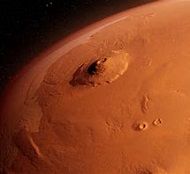
Data gathered shows that between 3.8 and 3.9 billion years ago Mars was subjected to an intense period of asteroid strikes. This period is known as the Late Heavy Bombardment. It is thought that this period caused the destruction of Mars’s potential for life. Luckily for us, the Earth survived this period. Scientists have been trying to understand what happened. In 2005 NASA launched the ‘Atlas V’ rocket carrying the ‘MRO’ (Mars Reconnaissance Orbiter) to investigate the evolution of Mars. In the last 16 years the ‘MRO’ has produced the vast majority of the data we have of the Martian surface. The ‘MRO’ found evidence of former deep seas with hydrothermal vents. An important discovery as hydrothermal vents are significant to the potential for life supporting conditions – a good place to look for signs of life.
In September 2014, NASA’s “Mars Atmosphere and Volatile Evolution Mission” (MAVEN) mission arrived at Mars. This mission is focused on answering questions about what caused the planets dramatic climate change. MAVEN looked at the atmosphere for clues and discovered that gases are being lost from the Martian atmosphere to space. Over billions of years this loss has reduced the atmosphere of Mars, preventing it from retaining heat. Mars is also exposed to the solar winds which are stripping away the atmosphere due to the magnetic field not being strong enough to protect it.
ESA Exomars is designed to search for signs of life. It is continually delivering high quality images. Although it is yet to find any conclusive evidence, more missions are planned to the surface of Mars which are set to further our understanding as the mysteries unfold. Manned missions are being planned. Orion is a new spacecraft from NASA. It is built to take humans further into space than ever before. It is in the advanced stage of testing and it is hoped that it will be suitable for a mission to Mars.
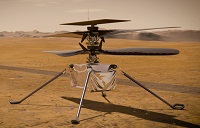
This month, February 2021, Mars is of particular interest. The UAE ‘Hope’ satellite has arrived in orbit to study the atmosphere of Mars. Also the Mars rover Perseverance is due to touch down on Thursday 18th February - the mission (Mars 2020) is to study a region called Jezero Crater. Perseverance will be the largest and most sophisticated vehicle to have ever touched down on another planet. Perseverance even has a helicopter called Ingenuity strapped to its underside – a Mars first for a demonstration of the tech.
Jezero Crater is in the equatorial region. The region is of particular interest to scientists because it is very old and may have within its geology preserved signs of past life. It was formerly considered too high risk to make a landing there but NASA are now confident that the new technology will get Perseverance to its safe landing area accurately. It is hoped that the mission will be able to answer a lot of questions about past microbial life. The rover is also going to run a test to see if oxygen can be extracted from the Martian atmosphere. If successful in its extraction of oxygen, NASA will be able to incorporate the science in their planning for manned missions.
The success of Perseverance will be dependant upon a safe landing. We wish the team the best of luck!
Perseverance - 'Mission 2020' February 2021 Update

On Thursday 18th February 2021 at about 8.50pm GMT, the Mars 2020 Perseverance Rover touched down in Jezero Crater. Mission control leapt in celebration once they knew the rover had survived the so called 7 minutes of terror through the Martian atmosphere and landed safely.
As soon as the team has checked Perseverance’s systems the science will be able to begin. The Ingenuity helicopter is not going to be involved in experiments. The use of Ingenuity is to trial the new tech from an engineering angle. The chopper however is equipped with good quality cameras and so we should all be able to enjoy real flight tours around the Jezero area if all works well - maybe a taste of things to come as a regular aspect of further missions.
We will be reporting again about the mission as things develop. In the meantime, to keep up to date, try visiting NASA Mars2020 or for a more interactive experience have a look at NASA Eyes
Mission Mars - March 2021 Update
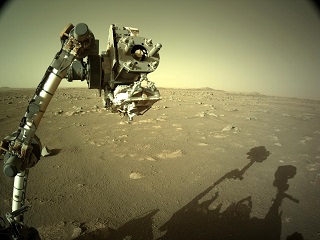
This is a busy time for Mars exploration. There are 11 active projects with spacecraft / landers exploring simultaneously:
Curiosity – Perseverance – InSight – Odyssey – Mars Reconnaissance Orbiter (MRO) – MAVEN – Mars Express – the Trace Gas Orbiter – the Mars Orbiter Mission – Tianwan 1 – Hope.
The most recent of these missions, by just a few days, is Perseverance. Since touching down the mission team have been running operational tests. On 5th March 2021, the rover drove across the Martian terrain for the first time.
For just over half an hour, the team were able to put Perseverance through it paces with a drive and test manoeuvring.
“This was our first chance to ‘kick the tires’ and take Perseverance out for a spin… The rover’s six wheels responded superbly. We are now confident our drive system is good to go.” said Anais Zarifian, a test engineer from the Jet Propulsion Laboratory.
The success of the test marked a major step of the mission before the science can begin. The initial point of touchdown, which Perseverance has now departed, has been marked with a name for posterity. The location will now be known as ‘Octavia E. Butler Landing’, named after the science fiction author.
Throughout the test phase, the high quality cameras have been busy, sending literally thousands of images, providing fascination and information in equal amounts to the team. They see the sheer volume and quality as a real advancement over previous missions.
Mission Mars - April 12th 2021 Update - Ingenuity Helicopter Test
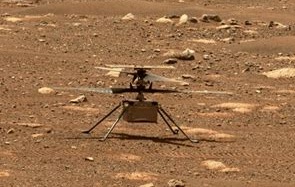
NASA’s plan to trial the Ingenuity helicopter was scheduled for Sunday 11th April 2021. This would have been the first attempt at the controlled flight of a craft on another planet. The test however had to be cancelled. NASA have planned to make their attempt again on Wednesday 14th April although this date may change if the problem they observed with the pre-flight tests persists.
On the 10th April NASA released an official statement. "During a high-speed spin test of the rotors on Friday, the command sequence controlling the test ended early due to a 'watchdog' timer expiration. This occurred as it was trying to transition the flight computer from 'Pre-Flight' to 'Flight' mode. The helicopter is safe and healthy and communicated its full telemetry set to Earth. The watchdog timer oversees the command sequence and alerts the system to any potential issues. It helps the system stay safe by not proceeding if an issue is observed and worked as planned."
If NASA manage to resolve the issue, Ingenuities first flight will be an exciting first. Ingenuity is equipped with a camera which should add a dimension to the mission never seen before.
Mission Mars - April 19th 2021 update – First flight of Ingenuity
On Monday 19th April 2021, the Ingenuity helicopter took its first flight. The successful test from NASA has become a landmark event, seeing the first powered flight of a craft on another planet. The helicopter went up three metres and hovered before returning to the planets surface. This success means that NASA’s plans for much longer and complex flights can now be attempted and possibly even contribute to the wider mission.
It is an amazing achievement in unprecedented conditions. Mars has less than 1% of the atmosphere of Earth and only a third of the gravity. The engineers were not sure that the technology would even fly in the Martian environment. To give it the best chance, the rotors were rotating at 10 times the speed of those you would find on Earth. It now appears that their enthusiasm and dedication has paid off. In anticipation of their success and the significance of it being the first flight, NASA had included a few grams of material from the wings of the original Wright brothers plane, by embedding it into Ingenuity’s structure – a connection that brings a deeper dimension to the occasion.
Ingenuity Rises To Success – Mission Mars Update 1st May 2021
During that last 24 hours, NASA has declared the Ingenuity Helicopter technology demonstration to be a success. The announcement follows the fourth and final test which began at 14.49pm GMT on Friday 30th April 2021. Ingenuity took off from the surface of Mars, reaching a height of 5 metres before flying 133 metres south. The journey, which returned Ingenuity to its original position, lasted for 117 seconds which is the longest time so far that the craft had been in the air.
Thomas Zurbuchen, NASA’s Science Mission Directorate associate director said, “ The Ingenuity technology demonstration has been a resounding success.” In our last update we predicted that a success would result in a much wider remit for the amazing little helicopter. NASA now plans to use Ingenuity to aid the science exploration of Perseverance.

“Since Ingenuity remains in excellent health, we plan to use it to benefit future aerial platforms while prioritizing and moving forward with the Perseverance rover team’s near-term science goals.” Thomas Zurbuchen
The mission has proved that powered flight on another planet is possible. The success has broadened the range of possibilities for future missions. The images received are quite literally out of this world.
The image was taken by the Perseverance rover yesterday (Sol 69), of the Ingenuity Helicopter in flight.
Mission Mars Update 1st June 2021
The Mars 2020 Perseverance team are now receiving masses of data. So much that their planning has needed the attention of a systems upgrade to ensure they do not overload Perseverance with their planed days activities. The team has developed COCPIT (Component-based Campaign Planning, Implementation, and tactical software tool) which is based on an existing tool called Playbook. COCPIT is NASA’s first web based tool for planetary mission planning and scheduling. It enables the scientists and engineers to plan the rovers activities ensuring it has enough battery life, bandwidth and memory storage to achieve its tasks in the day.
Four other Mars missions and the ISS have used planning and scheduling tools. This new web based tool allows collaborative working from anywhere on Earth.
“The teams work on COCPIT and Playbook is paving the way for future software that supports human and robotic exploration of the Moon, Mars and beyond.” Rachel Hoover – NASA Team
In other news, Ingenuity has continued to successfully perform and in May, NASA released a 3D Video of Ingenuity flying over the Martian surface. If you have a pair of 3D glasses, click the link to follow Ingenuity. Ingenuity 3D Video
Mission Mars Update July 2021
Mars Helicopter Ingenuity has experienced problems during its 6th fight.
During a flight that was intended to demonstrate its capabilities in aerial imaging, the helicopter began pitching back and forth in an oscillating pattern. Mission control attempted to find and fix the problem which caused the erratic flight. Despite the mini crisis, Ingenuity still managed to land safely.
NASA reports the issues began 54 seconds into the flight. A glitch has been found in the navigation system which uses images to support a stable flight. Apparently, a single image was lost which caused subsequent calculations during the flight to be inaccurate – leading to the instability due to inaccurate time stamps.
While the flight uncovered a timing vulnerability that will now have to be addressed, it also confirmed the robustness of the system in multiple ways. Harvard Grip, Ingenuity’s Chief Pilot
Perseverance takes first Samples
Its been almost 6 months since the Perseverance Rover touched down on 18th February. Since that time, the rover has gone through a huge number of systems test to ensure that it is functioning and able to deliver the demands of the team.
In June, the first phase of the missions science projects began. The first area to be explored was what is thought to be the oldest layers of exposed bedrock in a 4 square kilometre area of Jezero crater.
In July the team began preparations for a landmark event. Perseverance is to begin taking its first samples. For the first time on Mars, the samples are intended for a return trip so that they can be looked at more closely on Earth. It took Neil Armstrong less than 5 mins to collect the first moon samples. It will take Perseverance 11 days to complete its first sampling task, receiving instructions form millions of miles away.
“When Neil Armstrong took the first samples from the Sea of Tranquility 52 years ago, he began a process that would rewrite what humanity knew about the Moon. I have every expectation that Perseverance’s first sample from Jezero Crater, and those that come after, will do the same for Mars. We are on the threshold of a new era of planetary science and discovery.” Thomas Zurbuchen, associate administrator for science at NASA Headquarters.
Perseverance – if at first you don’t succeed…
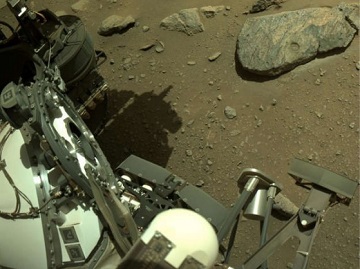
On 2nd September 2021, the Perseverance team began their second attempt to take a core sample from the Martian rocks. They had attempted to take a sample early in August but the rock sample was too crumbly. The sample broke into bits and the team were unable to get it into the sampling tube.
After relocating the rover to a rocky ridge area which the team are calling “Citadelle”, they found a target for their next attempt at taking a sample. The picture is of the rock targeted for sampling. The team have given the rock the nickname of “Rochette”. In the image there is a circular abrasion, made by Perseverance, as part of the assessment to decide if there is value in taking a core sample.
The team hope that this rock may be containing signs of life which can be revealed in a core sample. Finding signs of life is a key mission objective of Perseverance.
Regular Mission Updates
The Perseverance Rover and Ingenuity helicopter are now fully engaged with the science program; gathering data, samples and imagery. We will continue to bring you news of any major finds and developments. For regular ongoing updates of the mission's activities try the links below:




